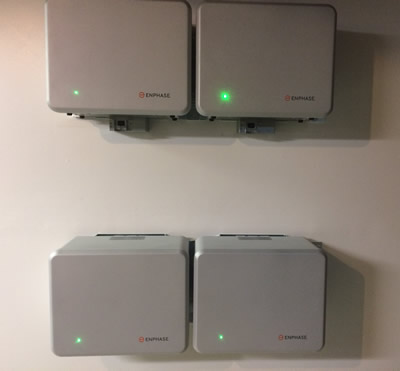Welcome to the
Run on Sun Monthly Newsletter

In this Issue: |
March, 2017
Volume: 8 Issue: 3
What's Wrong with this Picture?We occasionally encounter potential clients who have been given wildly optimistic proposals that promise amazing performance and use every square inch of the roof, regardless of the major shade issues of the site. We recently drove by a house that suffered from this exact problem.
After some research (gotta love online permit databases!), we determined that this is a 9.54 kW system consisting of 36 265 Watt panels. We analyzed the system’s potential performance assuming that the installer used the best products on the market (i.e., LG solar panels and Enphase microinverters). Based on the satellite image of this property, we see that most of the roof is in full sun. The overall system has 5 panels south facing, 6 east, 10 on a flat roof, 6 west in full sun, and our suspect 9 panels on the west roof in almost full shade. For our analysis, we used a 50% solar access value for those 9 panels (a very generous assumption). The rest of the system was assumed to have minimal shading. Based on those assumptions, this system is likely to produce 217,875 kWh over the next 20 years. Of that, only 30,726 kWh will be produced by those 9 west-facing panels. What that means is that 25% of the system (9 panels of 36) is only going to produce 14% of the system’s energy, and that is based on a very generous assumption about how much sun actually reaches those panels. Put another way, over the life of the system, at best, those 9 shaded panels provide half as much value to the homeowner as the rest of the array. What you see in that picture is the result of an installer who failed to provide their customer with enough information to make an informed decision. Instead, the customer was sold the biggest system possible to maximize the installer’s profit, not the customer’s benefit. If you are comparing solar bids, and one company is proposing a much larger system than the others, you might want to ask, who will those extra panels benefit the most? |
“Put another way, over the life of the system, at best, those 9 shaded panels provide half as much value to the homeowner as the rest of the array…”
Help Us Spread the News!


Solar + Storage = $avings!We have been waiting a long time for this moment, when we could finally say that we can offer a solar plus smart storage solution for our residential clients. Well the wait is over, and if you act fast, there is even a sweet rebate available! It is a complicated picture, so stick with us as we break this down. Introducing the Enphase Energy AC Battery
So how does this work? Consider SCE's TOU rates - the cheapest energy (13.1¢/kWh) is from 10 p.m. to 8 a.m. The next cheapest energy (16.6¢/kWh) is from 8 a.m. to 2 p.m., and 8 p.m. to 10 p.m. The really expensive energy (a whopping 33.5¢/kWh!) is from 2 p.m. to 8 p.m. - precisely when most people are coming home from work or school, turning on the A/C, and lights, and the TV and on and on. Ouch! But note that the peak time does not coincide well with the output from the PV array, meaning energy exported onto the grid during the day is worth half of what that same energy would be worth later in the day. That problem is exactly what the Enphase AC Battery is designed to solve. Each morning when the PV array "wakes up" it starts to power the local loads of the house. As the system produces more power, excess power is routed to charging the batteries (instead of exporting onto the grid). Once the batteries are fully charged, any excess power is then exported and the homeowner gets a net metering credit for that energy. But now when we get to 2 p.m. and the energy rate kicks into high gear, any energy needs that cannot be met by the PV array is supplied by the energy stored in the batteries, thereby limiting the amount of really expensive energy that has to be purchased from the grid. Here's a recent day's performance of the beta system (I told you the data was cool!): The bright blue is energy from the array, the orange represents energy loads - pale orange is entirely offset, bright orange is drawn from the grid. The green at the bottom shows the percentage of battery charge - sloping up between 8 a.m. and noon, constant until needed starting around 6 p.m., and then discharging to offset the household loads. At the top we see snapshot data from the 8-8:15 p.m. interval. No power is available from the array (duh, it's night!), but the house is consuming 533 Watt-hours of energy, with slightly more than half coming from the batteries. (Hint - the system is entirely modular, so we could easily double the size of the system to completely cover those loads.) Bottom line: if you are on a TOU rate, storage can really improve the value of your existing PV system. (And because the Enphase storage system is "AC-coupled" it can be installed with any existing PV system!) The SGIP Rebate ProgramWhich brings us to the Self Generation Incentive Program (SGIP) rebates. Starting in April, rebate applications can be submitted for energy storage systems. Much as the CSI rebate program had multiple steps over time, SGIP has five incentive level steps and how fast it steps down is tied to how large is the demand for rebates. (We anticipate that the highest rebate level will be paid out almost immediately after the program formally opens on May 1.) At this highest rebate level we would expect the rebate for each Enphase AC Battery to be roughly $430. The competition for these rebates will be pretty fierce. Fortunately, there is a dedicated carve-out of money for small residential storage systems, so all the money won't be gobbled up by a few, super-large projects. (Interestingly, priority will be given to folks living in what is known as the Western LA Basin Local Reliability Area - you can check to see if your zip code, which includes pretty much all of the Run on Sun service territory - is included by clicking here.) The rebate is not limited to SCE customers; folks who are SoCal Gas customers (that means you, PWP and LADWP folks!) can also participate. Go with the Pros!Properly sizing a battery system to go with your solar array is a complicated process that requires technical savvy. Dealing with the SGIP bureaucracy requires a sophisticated team that can deal with the program's many twists and turns. If adding storage - specifically the Enphase AC Battery - to your present or planned PV system sounds like a good idea, give us call, we're ready to bring our expertise to bear to help you get this right! |
Solar Gets Serious about Consumer ProtectionWe have long advocated for stronger consumer protection in the solar industry, warning that we will face a serious backlash if we don't do more to police ourselves. In fact, the Oregon Campaign for Accountability just filed a 103-page letter with the Oregon Attorney General's office alleging "false and misleading acts in the marketing and sale or lease of solar panels, in apparent violation of Oregon law." Ouch! But the news is not all bad. The good folks at SEIA just launched a national consumer education campaign. From their press release: WASHINGTON, D.C. - The Solar Energy Industries Association (SEIA), the national trade association for the solar industry, is launching a nationwide consumer education campaign to inform and protect solar consumers while further simplifying the process of going solar. Closer to home, our own CALSEIA (of which Run on Sun is a proud member) has its own consumer protection campaign featured prominently on their website. Unfortunately, not every solar company belongs to these fine organizations. So what is a consumer to do? Check! Here's a link to the CALSEIA member directory - if the solar company you are considering is not a member, ask them why not. Checking is one more step to help you find an ethical installer who will treat you right! |



